Overview
This article presents critical insights into size exclusion chromatography (SEC) within the realm of high-performance liquid chromatography (HPLC). It underscores the significance of SEC in biopharmaceutical applications, particularly in the accurate characterization of biomolecules, which is essential for ensuring product safety and efficacy. The discussion highlights the current growth of SEC, driven by recent technological advancements such as ultra-high-performance liquid chromatography (UHPLC), which significantly enhances efficiency and resolution in analytical processes. These innovations not only improve operational capabilities but also reinforce the importance of high-quality scientific instruments in laboratory settings.
Introduction
Size exclusion chromatography (SEC) stands as a pivotal technique in the domain of high-performance liquid chromatography (HPLC), particularly within the sphere of biopharmaceutical research. This method’s capacity to separate biomolecules based on size significantly enhances the accuracy of molecular weight determinations and plays a crucial role in ensuring the safety and efficacy of drug products.
As the demand for innovative therapies continues to escalate, it becomes essential to grasp the latest advancements and best practices in SEC. Nonetheless, what challenges do researchers encounter in optimizing this technique, and how might emerging trends shape its future applications?
JM Science HPLC Solutions: Advanced Instruments for Size Exclusion Chromatography
JM Science Inc. offers a comprehensive array of high-performance liquid chromatography (HPLC) solutions specifically designed for size exclusion chromatography HPLC. Notably, the AdvanceBio SEC products from Agilent Technologies excel in precision when analyzing biomolecules through size exclusion chromatography HPLC, enabling accurate size determination and aggregation profiling. Such capabilities are essential in biopharmaceutical laboratories, where reliable outcomes are paramount for drug development and quality assurance.
The use of size exclusion chromatography HPLC structures in biopharmaceutical applications is becoming increasingly prevalent, driven by the growing demand for innovative therapies and personalized medicine. Recent statistics reveal that the global size exclusion chromatography HPLC market is anticipated to reach USD 1.21 billion by 2033, reflecting a compound annual growth rate (CAGR) of 8.8%. Industry leaders underscore the significance of these structures, emphasizing their crucial role in maintaining the integrity and efficacy of biopharmaceutical products.
Furthermore, advancements in HPLC technology continue to enhance the efficiency of devices used in size exclusion chromatography HPLC, with manufacturers focusing on improved particle dimensions and pore distribution. This innovation not only enhances separation efficiency but also prolongs the lifespan of the columns, minimizing the need for frequent replacements. JM Science's dedication to delivering state-of-the-art instrumentation positions it as a vital partner for laboratories aiming to navigate the evolving challenges of biopharmaceutical research.
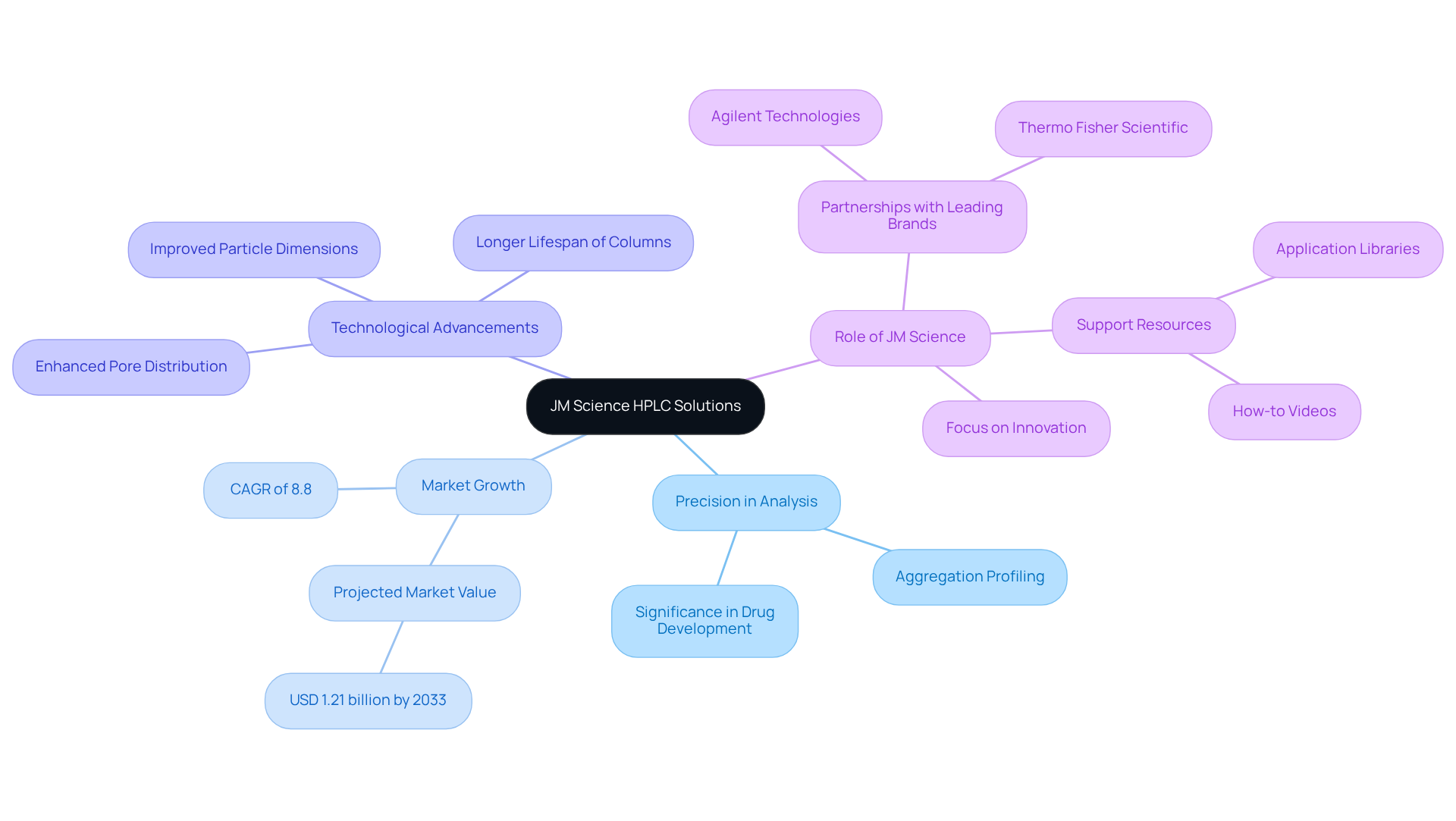
Understanding Size Exclusion Chromatography: Principles and Mechanisms
Size exclusion chromatography HPLC stands as a potent analytical method, adept at separating molecules based on their dimensions as they traverse a porous medium. The stationary phase consists of porous beads that permit smaller molecules to penetrate the pores while excluding larger ones, leading to their quicker elution. This technique, known as size exclusion chromatography HPLC, proves especially beneficial for the examination of proteins, polymers, and other macromolecules, as it yields essential insights into their molecular weight and distribution.
The mechanism underlying SEC is straightforward: a sample mixture is injected into the apparatus, where separation occurs through molecular interactions with the stationary phase. Smaller molecules enter the pores of the beads, effectively increasing their path length and delaying their elution, while larger molecules, unable to enter the pores, elute more rapidly. This size-based separation is crucial for applications such as protein purification and polymer characterization, where a comprehensive understanding of macromolecular size and distribution is vital.
Current research underscores the versatility of size exclusion chromatography HPLC, showcasing its application across various fields, including biopharmaceutical development and vaccine production. For example, SEC is utilized to purify viral particles, ensuring that the final product is devoid of impurities. Moreover, advancements in size exclusion chromatography HPLC technology, such as ultra-high-pressure size-exclusion chromatography (UHP SEC), have significantly enhanced the speed and resolution of analyses, establishing it as a preferred method for characterizing complex biological samples.
Professionals in the field emphasize the importance of selecting appropriate conditions to optimize SEC performance. As André M. Striegel, a Scientific Advisor in the Chemical Sciences Division, aptly notes, "Choosing the most appropriate column or conditions - especially in SEC - is not always obvious." This statement highlights the necessity for careful consideration of factors such as pore dimensions, mobile phase composition, and flow rate to achieve reliable outcomes.
Furthermore, it is essential to acknowledge the limitations of size exclusion chromatography HPLC, particularly its restriction to size separation and the requirement for optimizing conditions to ensure effective results. The peak elution window of 5 minutes and the efficiency of specific columns, such as the DNACore AAV-SEC column, which exhibits the highest efficiency with 11,000 plates, further illustrate the effectiveness of SEC in practical applications.
In summary, size exclusion chromatography HPLC remains a cornerstone technique in analytical chemistry, delivering robust and reproducible results that enable accurate quantitation of macromolecular characteristics. This capability significantly advances research and development across various scientific domains.
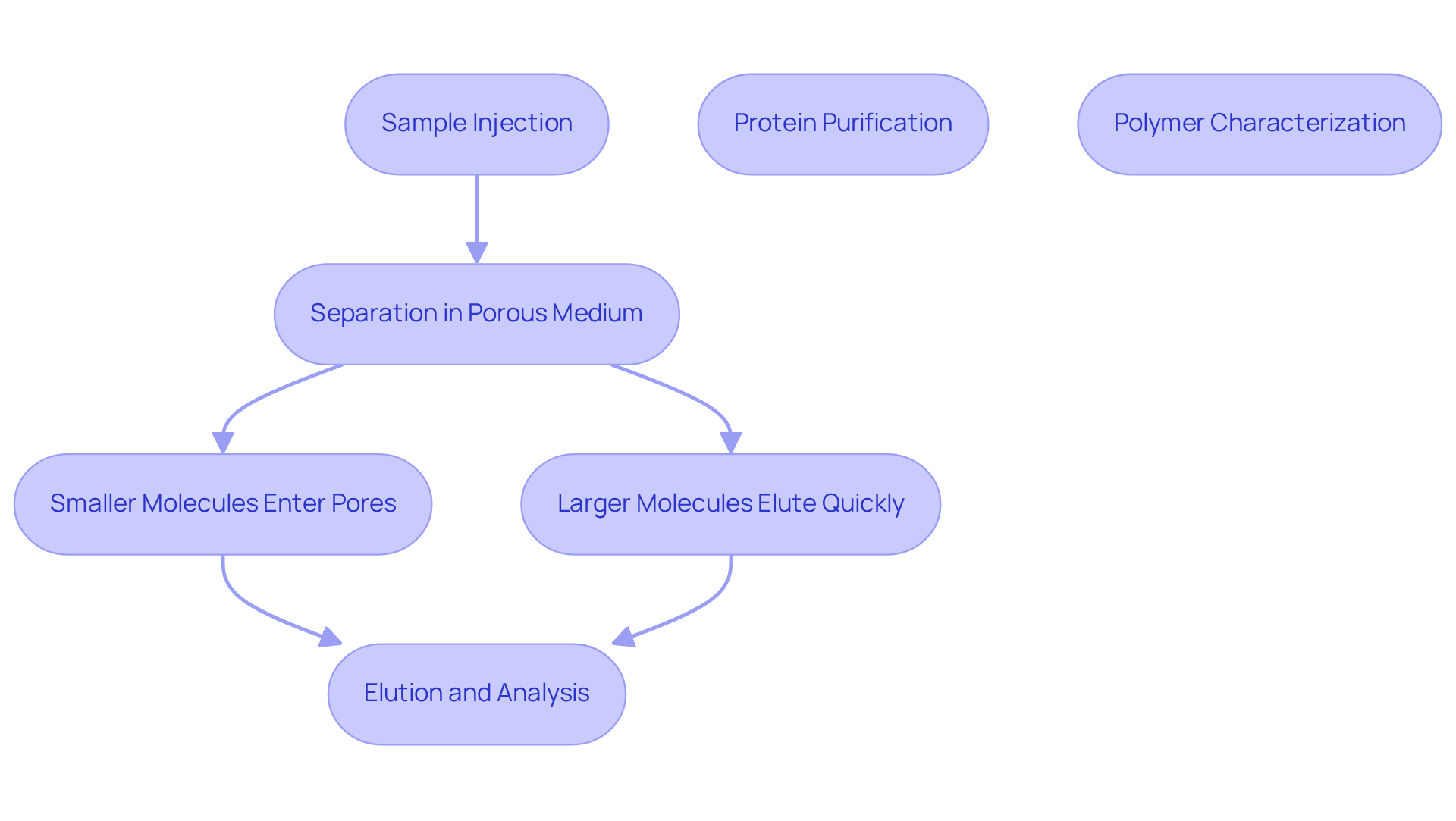
Key Components of Size Exclusion Chromatography: From Solvents to Detectors
Key components of size exclusion chromatography HPLC include the stationary phase, mobile phase, and detection systems. The selection of an appropriate solvent is critical, as it must align with both the analytes and the stationary phase to facilitate effective separation. Commonly utilized solvents such as phosphate buffers, Dimethylformamide (DMF), and Tetrahydrofuran (THF) are chosen for their ability to dissolve specific polymers and their compatibility with column packing materials.
Industry professionals emphasize that improper solvent choices can yield suboptimal results and compromise the integrity of the analysis. Detection systems, including UV absorbance, refractive index, and multi-angle light scattering (MALS), are vital for monitoring elution, providing quantitative insights into molecular dimensions and concentrations. Notably, SEC-MALS excels in analyzing proteins and biomolecules, offering valuable information that transcends mere molar mass and dimensions.
Thus, the judicious combination of suitable solvents and advanced detection systems is essential for achieving reliable and reproducible results in SEC applications.
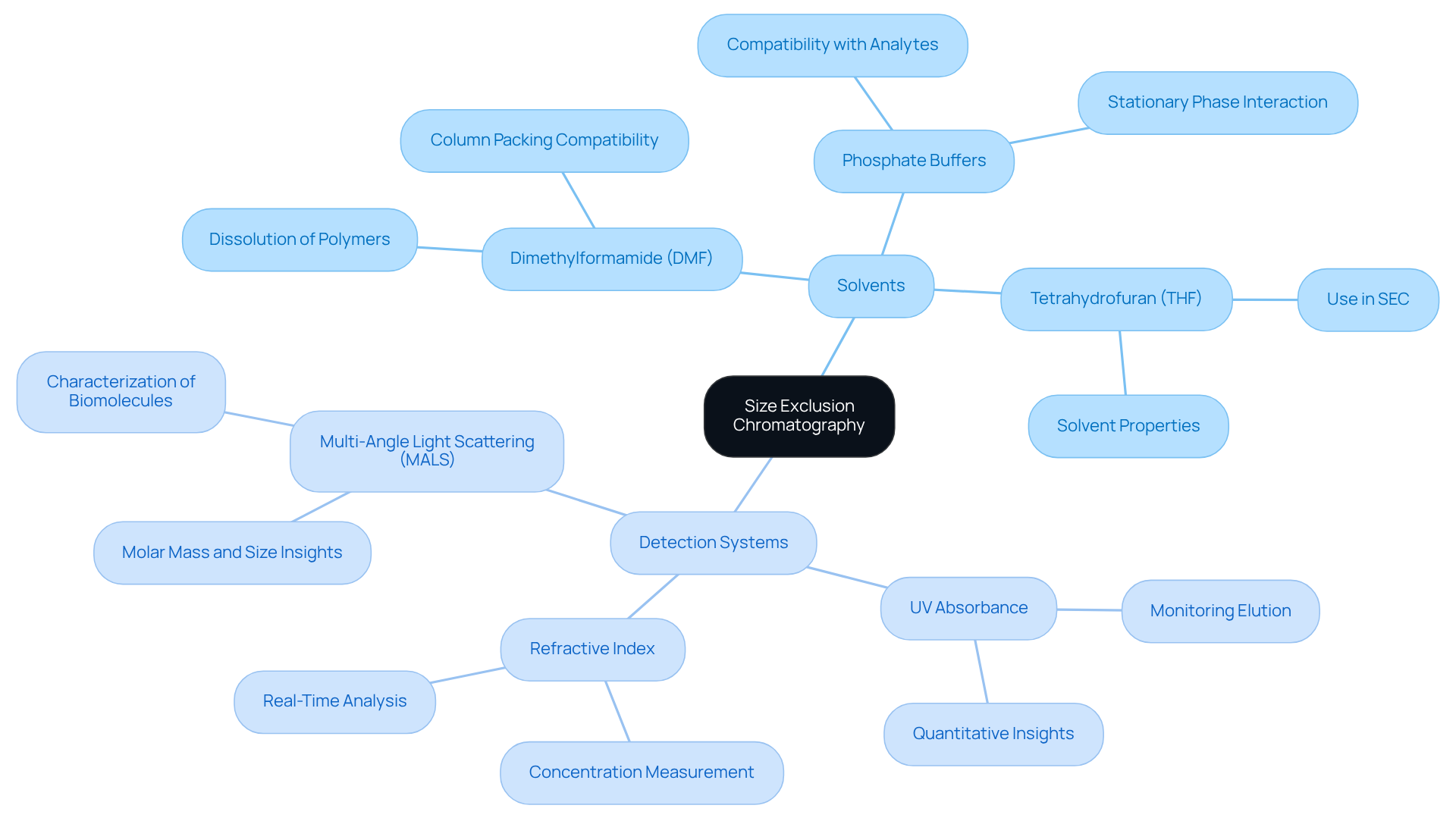
Applications of Size Exclusion Chromatography in Pharmaceutical Research
Size exclusion chromatography HPLC stands as an essential technique in pharmaceutical research, particularly for the characterization of proteins, peptides, and biotherapeutics. Celebrating its 60th anniversary in the 2020s, SEC utilizes size exclusion chromatography HPLC to play a pivotal role in assessing product purity, determining molecular weight, and analyzing protein aggregation—elements critical for ensuring the safety and efficacy of drug products. Its application is expanding in the development of antibody-drug conjugates and gene therapies, where precise measurements are vital for optimal product performance. Notably, SEC can separate macromolecules as large as 300 nm and, with caution, up to 500 nm in radius, highlighting its versatility in managing various macromolecule dimensions.
Recent advancements in size exclusion chromatography HPLC technology have markedly improved its utility in drug development. The optimized SEC method has been fully qualified for product release, adhering to acceptance criteria outlined in ICH Q2 (R1), which provides guidelines for the validation of analytical methods. This method facilitates aggregate content quantitation within ten minutes, exemplifying the efficiency of contemporary SEC techniques. Furthermore, the introduction of innovative mobile phases, including those with arginine, has demonstrated a reduction in secondary interactions, thereby enhancing the resolution and quantification of monoclonal antibodies (mAbs).
Pharmaceutical researchers underscore the significance of size exclusion chromatography HPLC in ensuring the safety of drug products. As experts in the field assert, "SEC provides critical insights into protein aggregation, which can directly impact drug efficacy and immune response." The ability to differentiate macromolecules across a wide spectrum, from monomers to ultra-high molar mass substances, underscores the adaptability of size exclusion chromatography HPLC in characterizing complex biopharmaceuticals.
Real-world applications of SEC encompass its role in evaluating the purity of therapeutic proteins and assessing the stability of formulations. For instance, studies have shown that SEC can effectively determine the retention time of monoclonal antibodies, yielding valuable data for quality control in biopharmaceutical manufacturing. However, practitioners must remain vigilant regarding challenges associated with SEC, including the necessity for meticulous calibration and potential inaccuracies stemming from sample heterogeneity. As SEC continues to advance, its integration with other analytical techniques, such as mass spectrometry, holds promise for further enhancing the characterization of protein products, ensuring they meet the stringent standards required for clinical use.
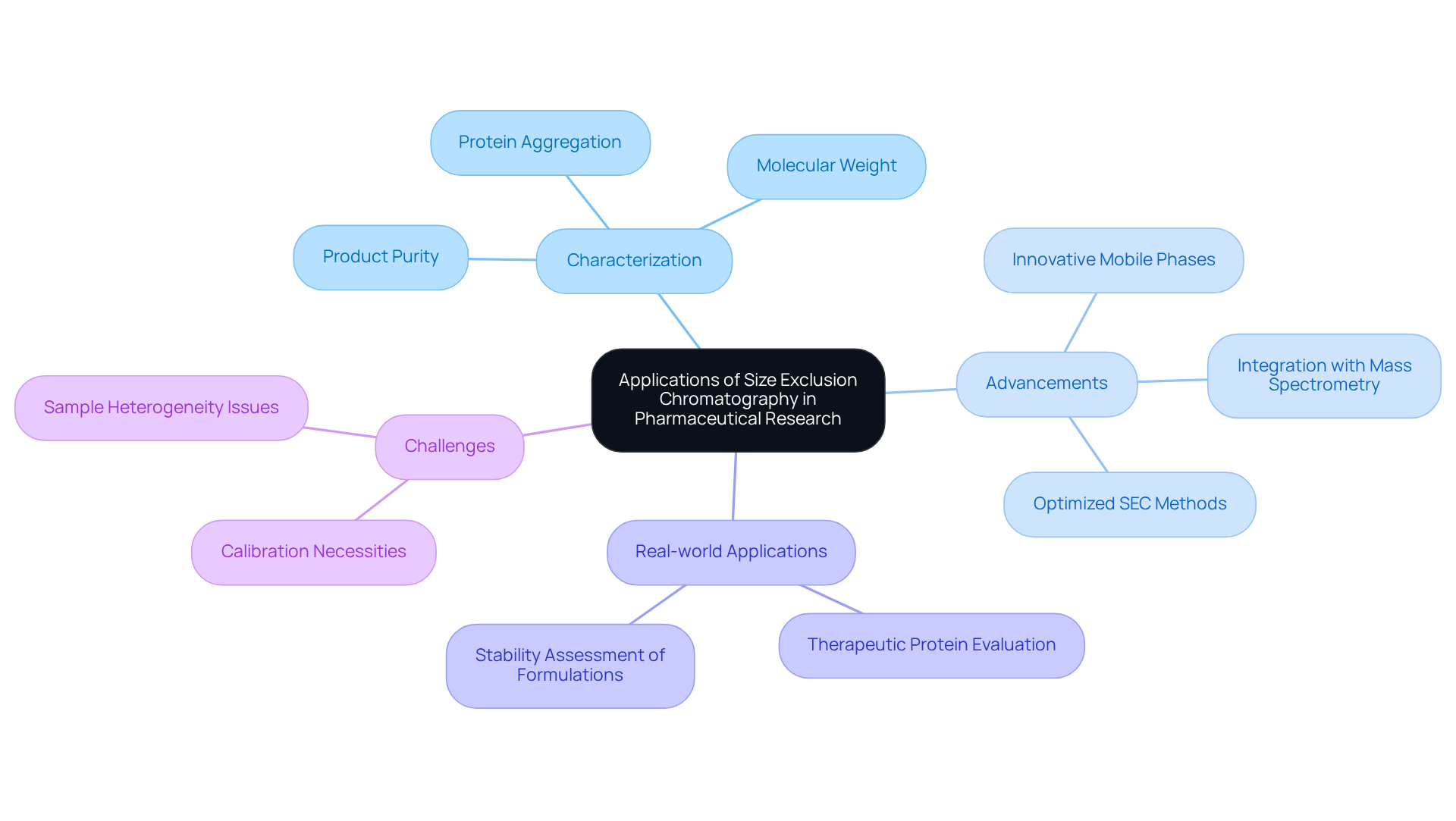
Calibration Techniques for Accurate Size Exclusion Chromatography Results
Calibration in size exclusion chromatography HPLC is essential for establishing a reliable relationship between the retention times of known standards and their corresponding molecular weights. Commonly employed calibration standards, such as polystyrene and polyethylene glycol, are favored due to their well-defined molecular weight distributions.
Regular calibration is imperative to accommodate variations in column performance and solvent conditions, which can significantly impact analytical outcomes. To achieve optimal results, methodologies like relative calibration and the application of well-defined standards are strongly advised.
Research indicates that utilizing these standards can enhance the accuracy of SEC measurements, ensuring reproducibility across diverse experimental setups. Experts emphasize that consistent calibration practices are crucial for preserving the integrity of outcomes in size exclusion chromatography HPLC, as they help mitigate discrepancies that may arise due to changes in operational parameters or sample characteristics.
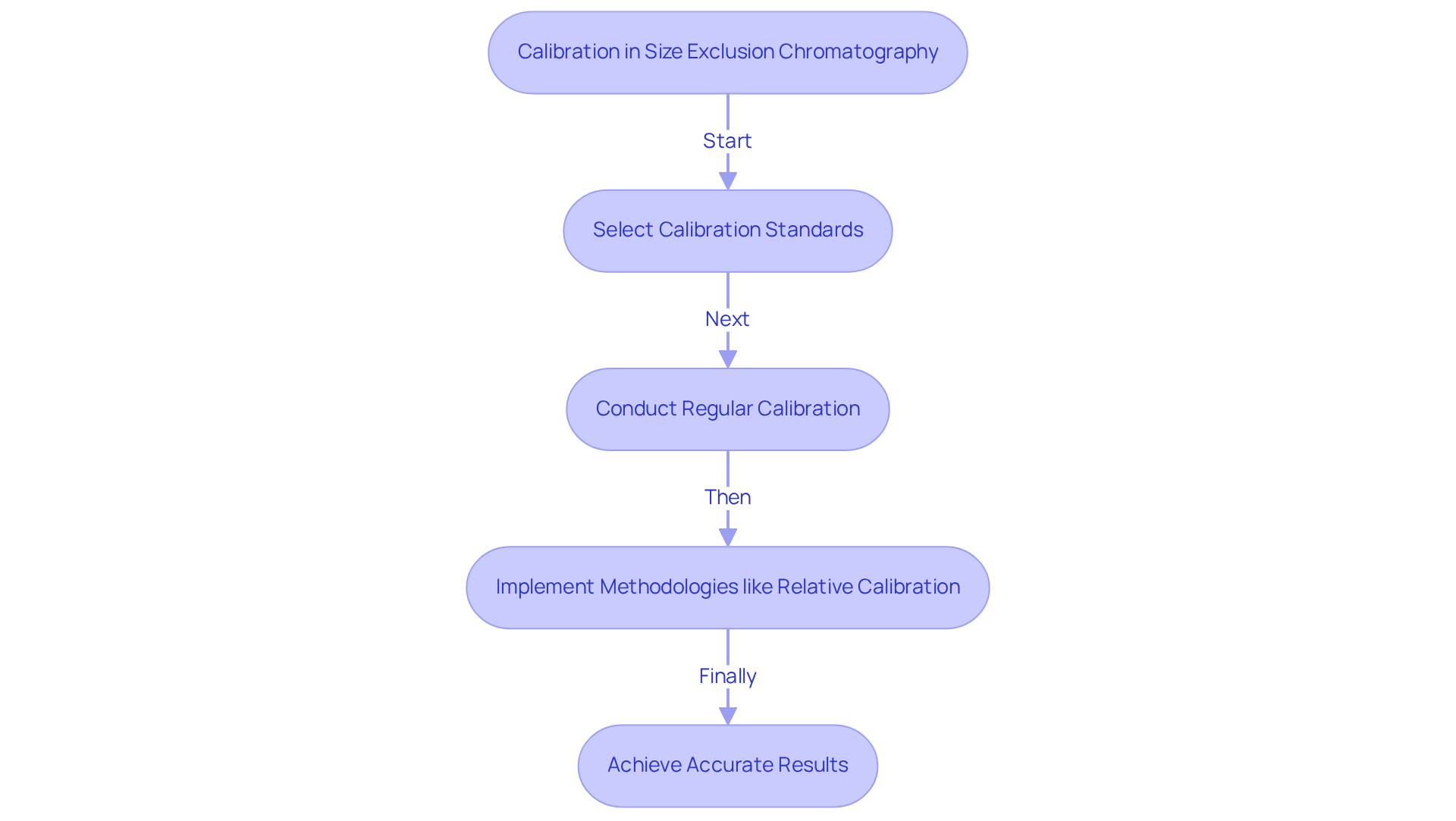
Optimizing Size Exclusion Chromatography: Challenges and Best Practices
Enhancing size exclusion chromatography HPLC is essential for addressing frequent issues such as clogging, inadequate resolution, and unreliable outcomes. Key best practices include:
- Selecting the Right Pore Size: Choosing a column with an appropriate pore size tailored to the target analytes is crucial for effective separation. This ensures that molecules of different sizes are precisely distinguished, thereby improving the quality of the outcomes.
- Maintaining Optimal Flow Rates: The flow rate of the mobile phase significantly impacts both separation time and resolution. Adjusting flow rates can prevent on-column degradation and turbulence, which could compromise data accuracy.
- Proper Storage and Cleaning: Regular maintenance and cleaning of SEC supports are vital for preventing contamination and degradation. Adhering to manufacturer instructions for solvent storage and cleaning procedures helps preserve the integrity of the supports, ensuring dependable analytical outcomes.
- Using Appropriate Solvents: The choice of solvents affects sample behavior during separation. Utilizing solvents with suitable viscosity and ionic strength can stabilize samples and minimize unwanted interactions with the stationary phase.
- Regular Calibration of Detectors: Periodic calibration of detectors is necessary to maintain accuracy and ensure precise detection of eluted compounds. This practice enhances the reliability of analytical results and supports consistent performance.
Real-world examples illustrate the effectiveness of these practices. For instance, a study on size exclusion chromatography HPLC in polymer property prediction revealed that enhancing the design of the separation unit and mobile phase characteristics significantly improved resolution and accuracy in molecular weight distribution analysis. Additionally, advancements in size exclusion chromatography HPLC technology, such as the introduction of high-resolution structures with finer particles, have further enhanced performance capabilities.
By implementing these best practices, laboratories can achieve high-resolution separations and accurate molecular weight distributions, ultimately contributing to advancements in research and development across various scientific fields.
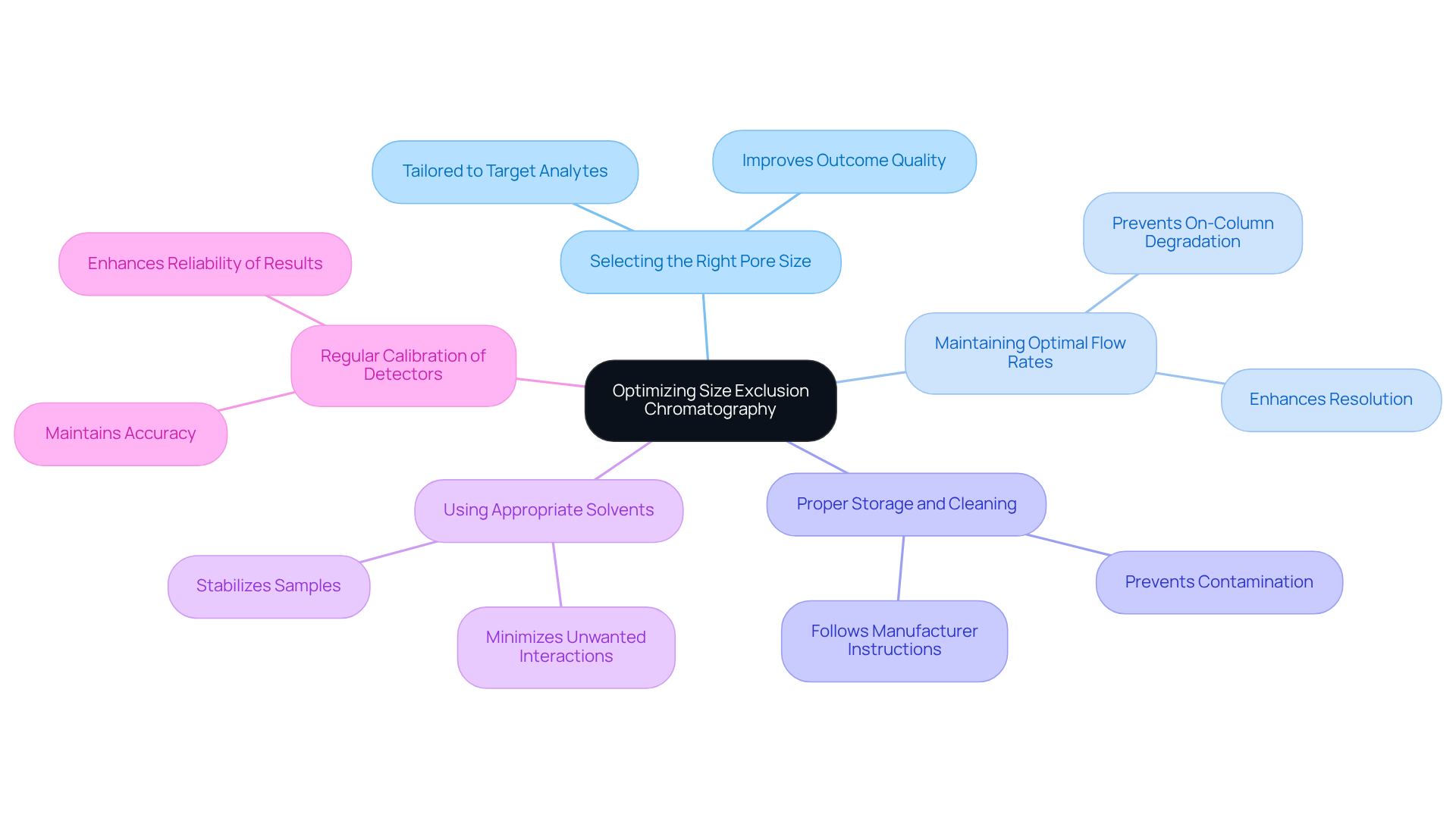
Emerging Trends in Size Exclusion Chromatography: Innovations and Future Directions
Emerging trends in size exclusion chromatography HPLC are significantly shaped by the rise of ultra-high-performance liquid chromatography (UHPLC) systems, which are revolutionizing the field with enhanced resolution and dramatically reduced analysis times. Methods that previously required run times of 50 minutes can now be completed in as little as 60 seconds, making UHPLC an appealing choice for laboratories striving to boost throughput and efficiency.
Innovations such as automated SEC systems are gaining traction, streamlining workflows and reducing human error. Additionally, the adoption of sustainable column materials is becoming increasingly crucial, mirroring a broader industry shift towards environmentally friendly practices. These advancements not only enhance operational efficiency but also align with the growing emphasis on sustainability within laboratory environments.
Detection technologies are also advancing, with the integration of Multi-Angle Light Scattering (MALS) and viscometry augmenting the analytical capabilities of SEC. These technologies facilitate a more thorough analysis of complex biomolecules, offering essential insights into their size and structure.
The global market for UHPLC systems is projected to witness substantial growth, with a compound annual growth rate (CAGR) of approximately 7.8% from 2023 to 2030. This growth is fueled by the increasing demand for advanced analytical techniques across various sectors, including pharmaceuticals and biotechnology. As the biologics market is anticipated to surpass $750 billion by 2030, the role of size exclusion chromatography HPLC in protein purification and characterization will become even more critical, underscoring the significance of these innovations in addressing the evolving needs of the scientific community. As Broughton Laboratories highlighted, "Run times using ultra high performance liquid chromatography can be 50 times shorter than with regular liquid chromatography," emphasizing the efficiency gains that laboratories can achieve.
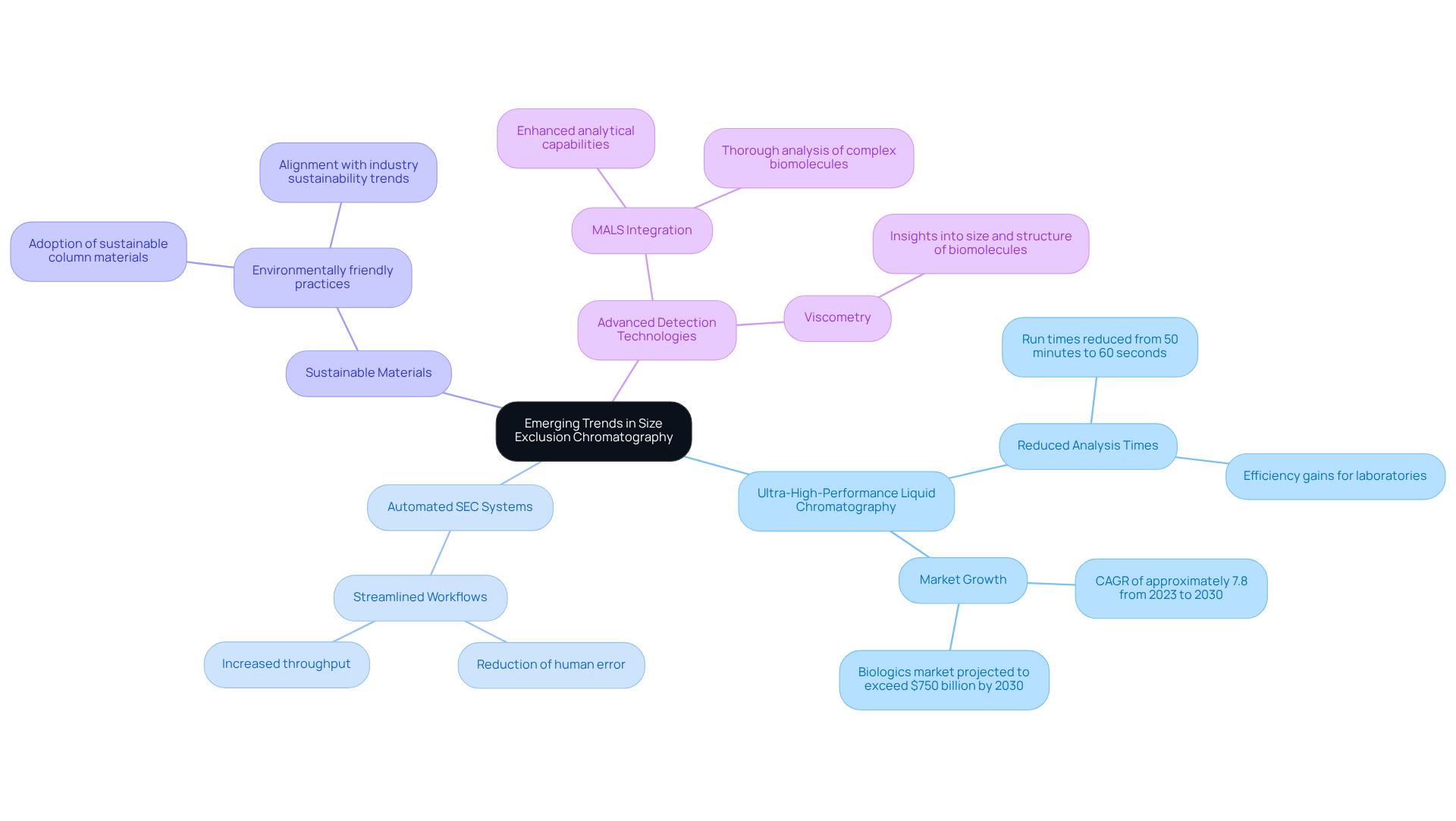
Conclusion
Size exclusion chromatography HPLC stands as an indispensable technique, playing a crucial role in the analysis and characterization of biomolecules, particularly within the biopharmaceutical sector. Its capacity to separate molecules based on size not only deepens the understanding of macromolecular structures but also safeguards the integrity and efficacy of therapeutic products. Given the escalating demand for innovative therapies, the importance of size exclusion chromatography HPLC in drug development and quality assurance is increasingly evident.
This article has presented key insights into the principles, mechanisms, and applications of size exclusion chromatography HPLC. The discussion underscores the necessity of selecting appropriate solvents and detection systems, the importance of regular calibration for accuracy, and best practices for optimizing the technique. Furthermore, advancements in technology—such as ultra-high-performance liquid chromatography and automated systems—are reshaping the landscape, facilitating faster and more efficient analyses that cater to the evolving needs of the scientific community.
The future of size exclusion chromatography HPLC is promising, with ongoing innovations set to enhance its capabilities further. As the industry pivots towards sustainability and efficiency, laboratories are encouraged to adopt these emerging trends and implement best practices to optimize their workflows. By doing so, they position themselves at the forefront of biopharmaceutical research and development, ultimately contributing to the advancement of safe and effective therapies for patients worldwide.




